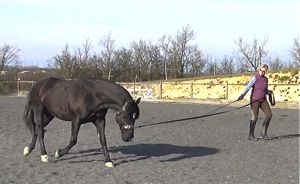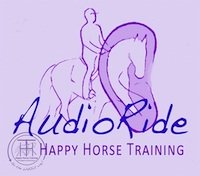|
Real Dressage Training Tips

What we call real dressage (to distinguish it from dressage based on superficial appearances) is founded on the gymnastic phenomenon of engagement, which involves the biomechanics of horse and rider connecting and operating in a particular way that creates balance and stability within a free flow of movement. It is a sad fact that many dressage riders never experience this wonderful state, constrained by requirements for precision and control, but once you do feel it, you will probably never want anything else from your riding! In good dressage, all corrections start with the rider. Here are some basic but essential ways you can start to find the right position to connect with your horse in a way that promotes engagement.
If you can get this connection with your seat, you should start to notice that your horse slows down and wants to stretch his head and neck down, raising his back (make sure you are not blocking him in front with the rein contact!). NB. The above dressage training tips are the foundation of how

These dressage training tips for the riding position may seem basic, but they form the foundation of the correct position and its interaction with the horse. Many riders sacrifice the correctly tucked and connected seat for a 'good' leg position, because the leg is more visible; they then sit with a fork seat perched against the horse's movement. Acquiring both a good leg AND seat is the work of years of persistent effort and diligent correction, but it is well worth it in the end.

These dressage training tips give some useful pointers, but for a comprehensive guide to lungeing and other work on the ground look at the HHT e-book How To Train A Horse Without Force. A unique, in-depth guide to training; it shows you not only how to build a relationship based on mutual trust, but also how to establish the right gymnastic development in your horse. 

NB. It is especially useful to do the exercise in the above dressage training tip in shoulder-in: can you keep your horse yielding sideways in a straight line without holding him there with your outside rein, softening nicely into your inside rein? This is the true verification of a correct shoulder-in - in itself a wonderful tool for generating straightness and engagement. If you can't create angle in your shoulder-in without holding the outide rein, then you need to develop more postural strength to turn the horse's ribcage. If you can't get enough bend or sideways yielding without the outside rein than you need to establish more inside leg aiding and yielding response from the horse. In all cases, it is vital that you don't allow your weight to be pushed to the outside by the horse's ribcage rotation.

We hope these dressage training tips towards work in engagement and without tension are useful to you and your horse. Remember that real dressage is about riding from the inside-out. Always prioritize your feeling of what's right - what feels good in terms of balance and connection - over external appearances or actions, such as your horse's precision and response to signals.
|
New from HHT!
AudioRide is a series of exercises designed to listen to while you ride.
Audio descriptions guide you through each step of developing a balanced, dynamic connection with the horse through your position.
This truly innovative learning tool gives you a whole new way of being guided in your riding, in a calm, clear, step-by-step way.
Free Download! Introductory Exercise: Riding in the Now
Click here for full details
The Gymnastic Rider eBook
Now available exclusively from HHT! A unique, comprehensive guide to practical rider biomechanics. This professionally produced eBook takes the rider through the process of developing their body in the specific way that brings the horse's movement into harmony and balance - without force and constraint. Click here for full details, and to download the 15-page introduction for free.
Join the Happy Horse Training group on Facebook!
See and share topical info, news and photo's, and take part in lively discussions.
Click here to go to the HHT group and then click on the 'join group' button.
Join the Whole Horse Newsletter
HHT's free monthly newsletter giving you wide-ranging and intelligent insights into holistic horsemanship.
Just enter your details below to join.
Free bonus on the riding position with all new subscriptions: Ten Top Tips To Instantly Improve Your Connection With Your Horse.
Click here to see back issues of The Whole Horse newsletter
Train Your Horse
The Holistic Way
How To Train A Horse Without Force is a unique guide to training horses through energetic connection and gymnastic training. Part 1 covers everything on the ground, from handling to the lungeing technique that develops strength, straightness and engagement. Comes with a free eBook supplement on Horse Trauma.
Click here for more details.
What people say about the eBook:
"OMG! I'm BLOWN AWAY by this text [...] It's one of the best horse training texts I've ever read." - Wendy Kendall
"I realized that I haven't yet written you about the impact that your training e-book has had on me, and I want to let you know how inspiring and helpful I found it. As a student of Zen Buddhism for nearly three decades, I've often wondered when someone was going to write the book on Zen and the art of horsemanship, and I think that your emphasis on mindfulness and energy connection gets right at the heart of the matter. It has certainly deepened the way that I relate to and communicate with my horses. I am reasonably sensitive to horses' body language and mood, but new to me was the idea of feeling their energy in a more subtle way - including their connection with me even when I am not directly working with the them. I have made myself more aware of this communication, and it's pretty amazing. I have started grooming differently, too, treating a grooming session as a time to mindfully listen to my horse instead of a way to dust out an old rug (OK, I wasn't quite that bad, but you get the idea). Additionally, I have made myself more open to how I actually feel about the horses themselves - very enlightening. Overall, I think that you are saying something that no one else is saying but that everyone ought to hear." - Tess Lloyd
Do You Have
A Horse Story
To Share On HHT?
So many people have been through wonderful experiences with horses, whether in training or otherwise. If you've made a change in a horse's life - or one has made a change in yours - tell us about it here.
Learn How To Trim
Your Own Horse's Feet
The Simple Seven-Step Natural Trim is a comprehensive step-by-step guide to a cutting-edge barefoot trim. Click here to find out more.
What people say about HHT:
"The riding instruction is outstanding, if instructors in the UK taught this way there would be a lot of happy riders and horses."
"The riding tuition exceeded my hopes and expectations by a long way; giving me an exciting new facet to horsemanship which is lighter. more subtle, more elegant and more meaningful. It is as if a new door has opened bringing more sunlight and air."
"My goodness - what a change has taken place in my riding. I think that I'm starting to sit 'into' the horse rather than on top of him. I felt my horse's movements in a way that has almost never happened before"
Click on Testimonials for more





 a rider can use their seat to initiate engagement - you will need to keep re-applying them and, over time, studying the effects on your horse in order to understand their significance. If you stick to this way of sitting, eventually you will gain enough postural strength to begin to channel and re-balance the horse's movement with your seat, and achieve consistent engagement.
a rider can use their seat to initiate engagement - you will need to keep re-applying them and, over time, studying the effects on your horse in order to understand their significance. If you stick to this way of sitting, eventually you will gain enough postural strength to begin to channel and re-balance the horse's movement with your seat, and achieve consistent engagement. 




